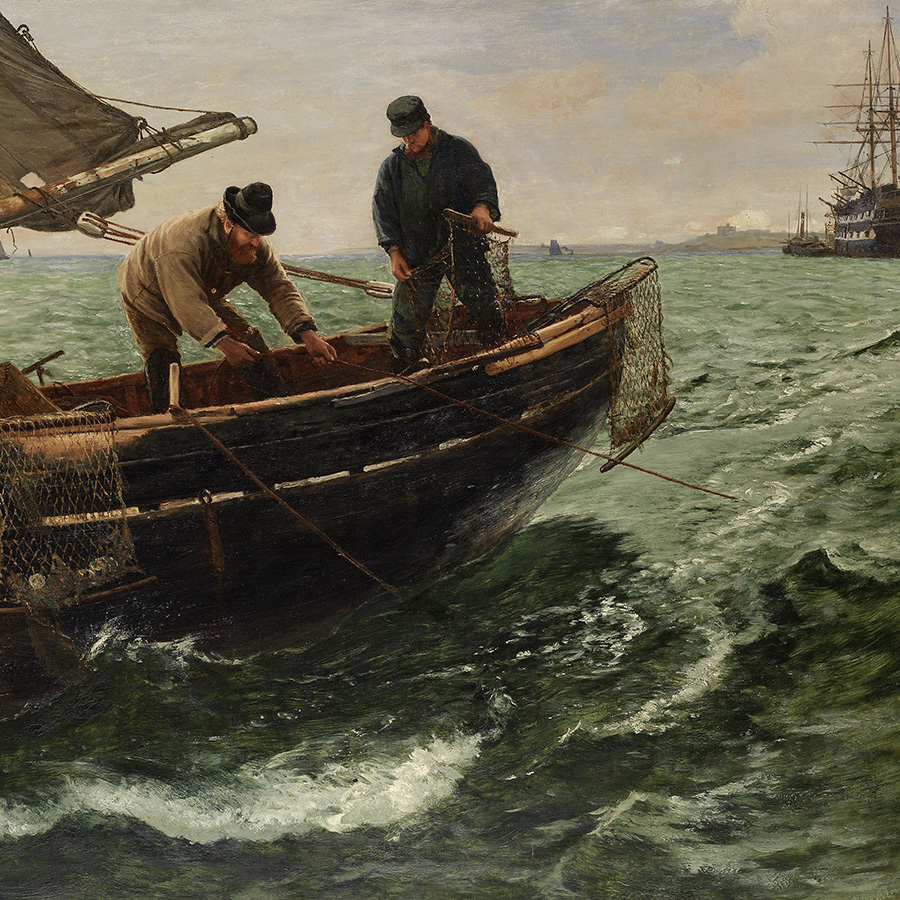

By Linda Batchelor
‘It was imprinted on my mind and I never forgot it’
This was the impression of sea and ships gained by ten-year-old Charles Napier Hemy on a voyage to Australia and which developed for him into a lifelong fascination.
From 1881 Charles lived and worked as an artist in Falmouth. In a letter of 1881 explaining his move to Falmouth to fellow artist Luke Fildes he wrote ‘I have built my house here so as to paint nothing but sea and ships and do them always from nature’. He came to be regarded as one of the greatest marine painters of his era.
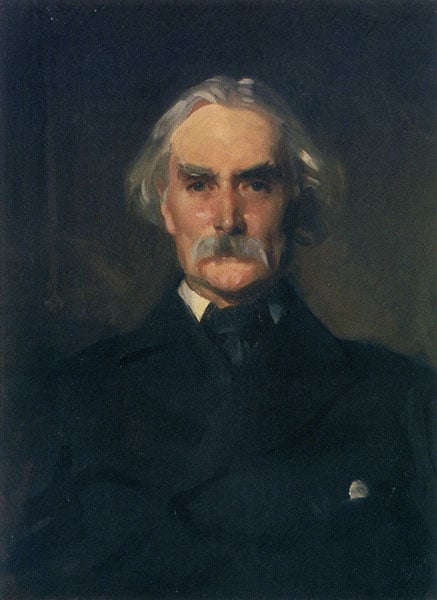
Portrait of Charles Napier Hemy, 1905 by John Singer Sargent, Falmouth Art Gallery.
Charles Napier was born in Newcastle on Tyne on 24 May 1841 into a musical family. His paternal grandfather Henry Hemi had come to Britain from Saxe Gotha, Lower Saxony in 1805 initially to serve as a musician in the Duke of Buccleugh’s Dumfries Militia. He had stayed in Britain changing his name to Hemy, had married in Scotland and settled with his family in Newcastle becoming well known as a teacher of music.
His son Henry Frederick was also a talented musician, who after a brief period at sea had returned home to establish a musical career and to marry Margaret McDonald. Charles Napier was their first child. In 1850, however, the family had financial difficulties and decided to emigrate to South Australia aboard the Madawaska bound for Melbourne and it was this voyage which was the catalyst for the interest which dominated Charles’ artistic career in later life.
The family only spent a few years in Australia which was also the time of a Gold Rush. It was reported that Henry Frederick was able to make sufficient earnings in the gold fields that on his return to England he was able to pay off his debts and resume his music teaching in Newcastle. He became a Roman Catholic and Charles followed him into the faith. Throughout his life as well as teaching he was a composer of both secular and religious music and was the organist at several churches in the surrounding area. In 1877 he was appointed as Professor of Music at Ushaw College the Catholic Seminary in County Durham.
On the return to Newcastle from Australia Charles, now aged thirteen, was enrolled at Newcastle’s Government School of Design. The first such School of Design was established in 1837 at Somerset House in London by the Board of Trade for the improvement of ‘ornamental art’ in manufacturing and other Schools were soon established in many of the manufacturing districts throughout the country. After the Great Exhibition in 1851 the operation of the Schools was transformed to encompass art as well as design and the training offered was opened up to a wider number of students, including women.
The Principal of the Newcastle School from 1843 to 1864 was John Bell Scott a friend and associate of Rossetti and the artists of the Pre-Raphaelite Brotherhood. This association was to have an influence on Hemy’s approach to his artistic work and to his future employment and career.
After his time at the Newcastle School Charles began to consider entering the priesthood but influenced by his youthful experiences on the long voyages to and from Australia he was also drawn to life at sea. At fifteen he became an apprentice seaman for a time but he suffered from ill health whilst at sea and was forced to return home to the family in Hartlepool.
In pursuit of a religious life he then joined a community of Dominican Brothers in Lyons in France. After a few years, although he remained a devout Catholic, he realised his calling was not sufficiently strong enough and that he needed to follow an artistic career. He left the community to study art further at the internationally acclaimed Academy for Fine Arts in Antwerp in Belgium followed by a period in the studio of the influential Belgian artist Baron Henri Leys, a painter of historical and romantic scenes and a pioneer of the realist movement in Belgium.
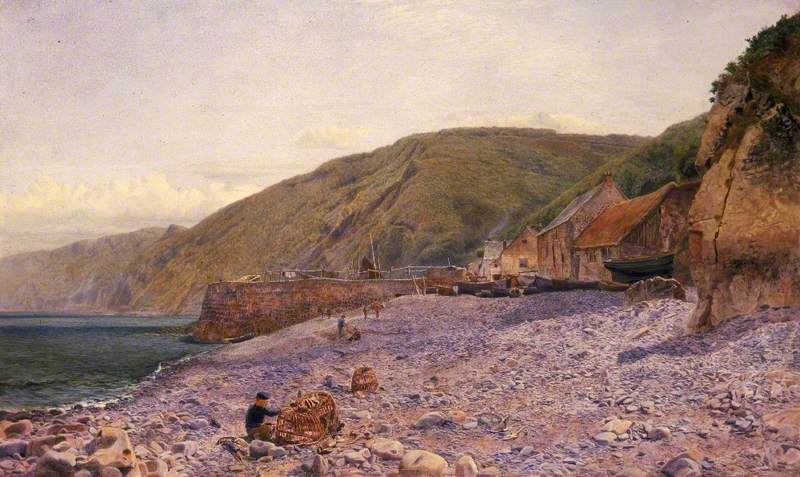
‘Among the Shingle at Clovelly, North Devon’ 1864, Charles Napier Hemy, Laing Art Gallery.
Hemy returned to England after the death of Leys and his work attracted its first public attention in 1864 with his painting ‘Among the Shingle at Clovelly’. In 1866 he married Mary Anne Lloyd and from 1866 to 1880 the couple lived in Fulham in London close to the River Thames. He worked for William Morris for a time at his Queen’s Square Stained Glass Workshop where he was introduced to fellow artist Edward Burne-Jones who became a lifelong friend. Hemy also had his own gallery studio in Fulham where he painted works in oil and watercolour. His subject matter at this time was mainly costume and semi religious subjects and landscapes but he often painted the shipping on the River Thames and other seascapes in the North East and South West. It was by the Thames at Putney that as a boy the artist Frank Brangwyn had first encountered Hemy painting, and the meeting had inspired a friendship and his own later artistic career.
Throughout the time he lived in London Hemy would spend summers painting in the harbours of Devon and Cornwall especially pictures of the sea and ships. He came to realise that although already successful this subject matter should be the focus of his work. This realisation prompted his permanent move in 1880 to Falmouth, which he had come to knew well, accompanied by his wife Mary. They had begun building their house named Churchfield in the town in Kimberley Place but soon after their move Mary died leaving him childless widower.
Hemy had come to know many of the leading figures in the town including his fellow artist Henry Scott Tuke and his sister Maria and probably through them the wealthy Freeman family who owned Freeman’s Granite Works in neighbouring Penryn. John Freeman and his brother had originally started granite quarrying around Penryn and in 1848 had leased land alongside the river for their dressing operations and easy shipping of the granite from the Port of Penryn. By the 1860s the works covered three acres between the two towns and Penryn became known as the Granite Port.
The family of William George Freeman lived in Falmouth, near to the Tukes, with a large family including two of their daughters Winifred and her elder sister Amy. William was one of the chief benefactors of St Mary’s Catholic Church which was opened in Falmouth in 1869. Winfred studied art with the artist Hubert von Herkomer at his art school and studio in Bushey. As part of the social and artistic scene in Falmouth and as devout Catholics the family would have known Hemy. In 1881 Amy, who was ten years younger than Charles married him at St Mary’s Church in Falmouth. They lived in Churchfield House throughout their married lives and had ten children.
As well as setting up his studio in Churchfield he also spent time painting in his floating studio the Van der Velde. This was a former seine boat which he had converted to use afloat with large windows to observe his subject matter of the sea and ships at close quarters. His friend Tuke also adopted the floating studio idea for much of his work. Unfortunately, after six years the Van der Velde was wrecked in 1888 when blown from her moorings at St Mawes but was recovered and taken to Churchfield where the boat was fixed on solid foundations in the grounds and used as a further studio. In its place Hemy had a yacht built as his sea studio named the Van der Meer. This was according to a journal article of the time ‘well-built and sumptuously furnished’. There was a ‘57 foot spacious teak cabin amidships lighted with large windows, from which the owner successfully studies his subject’
Hemy painted in both oil and watercolour and his work showed elements and influences from his various teachers and fellow artists such as Whistler and Tissot. His early work reflected the Pre-Raphaelite style and his mature style was looser with ‘an incredible sense of movement’ according to Hemy’s granddaughter Margaret Powell in her book ‘Master of the Sea’. However, attention to detail and careful draughtsmanship learned during his training were skills he maintained throughout his painting career. He was always sketching and made many individual studies as part of bigger pictures.
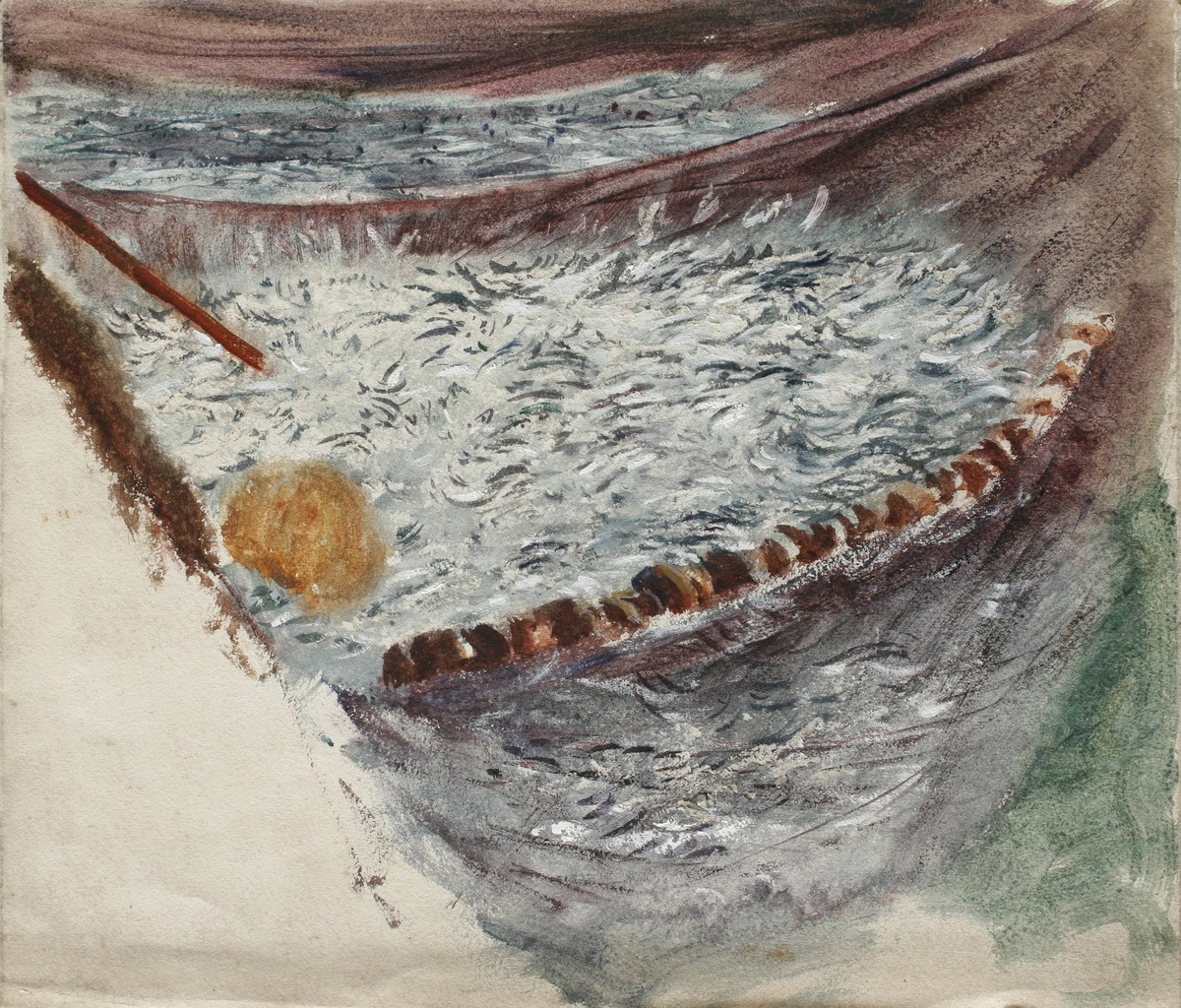
Study of Pilchards (for the Painting ‘Pilchards’), Charles Napier Hemy, Falmouth Art Gallery.
He painted ships and the sea from ‘nature’ and from detailed observation and understanding of sea conditions. Frank Brangwyn wrote that ‘as a draughtsman of wave forms he stands alone’. He was also able to present a realistic view of life and work at sea and to capture the working and sometimes recreational relationship of men and the sea.
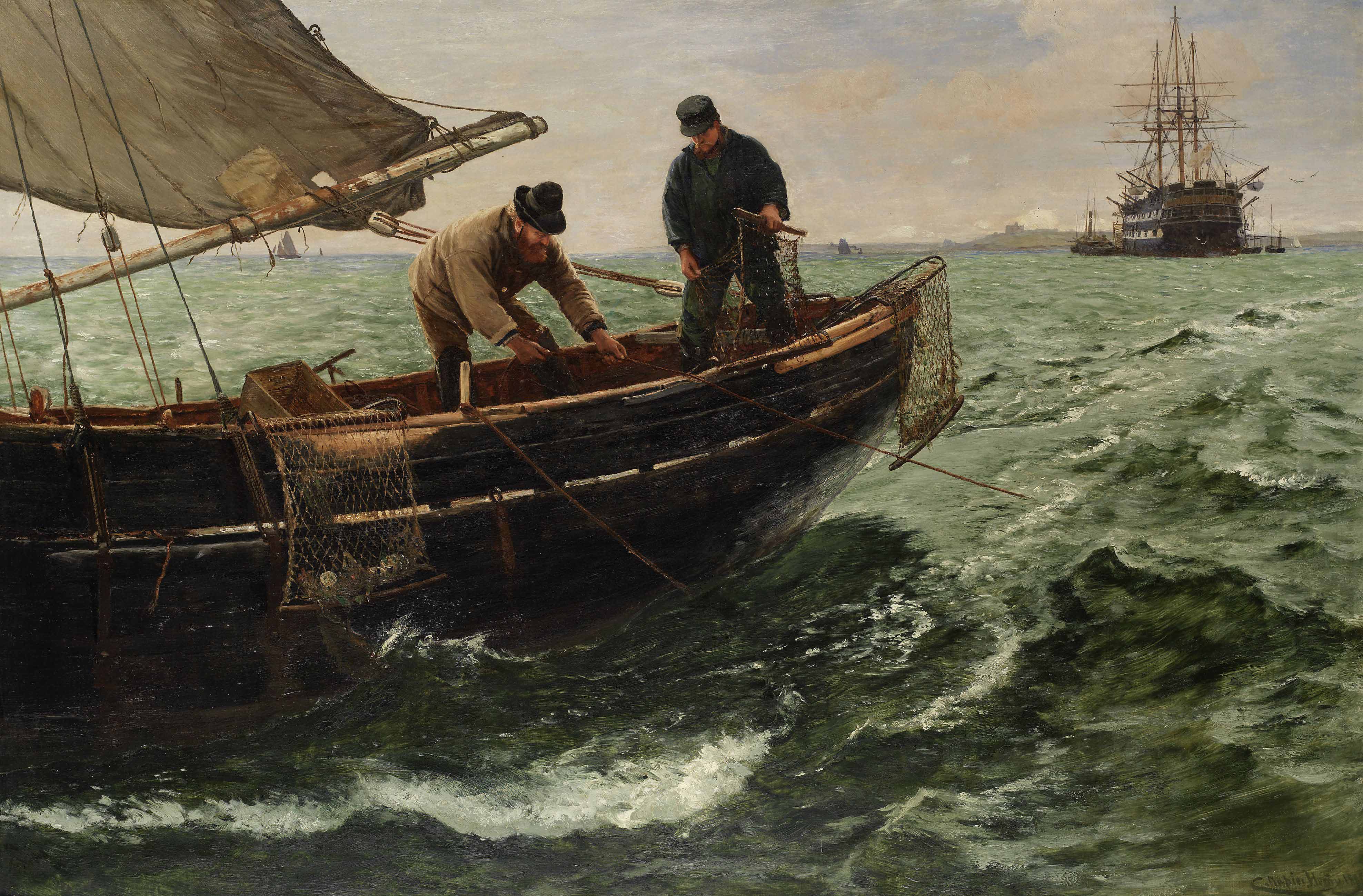
‘Falmouth Natives’ 1886 (Oyster Dredging off Falmouth), Charles Napier Hemy, Falmouth Art Gallery.
Hemy and Tuke were based in Falmouth but they were also part of the broader Cornish artistic scene. The two often visited Newlyn and St Ives and the artistic colonies there and had a reputation of being good raconteurs. They were also visited in Falmouth by many other artists and friends. Brangwyn had been a friend of Hemy from the first encounter by the Thames, had remained so and was a frequent visitor to Falmouth. In 1905 John Singer Sargent visited Hemy and painted his portrait.
Hemy exhibited frequently especially in London at the Royal Academy and the Old and New Societies of Painters in Watercolours. He also exhibited at the Opening Exhibition of the Passmore Edwards Art Gallery in Newlyn and he became the official painter for the Royal Yacht Squadron. He was made an Associate of the Royal Society of Painters in Watercolours and a Member in 1897. In 1898 he was elected as an Associate of the Royal Academy and as an Academician in 1910.
Hemy continued to paint the waters and maritime activities around Falmouth until the end of his life. He died at Falmouth on September 30th, 1917. His work is represented in many art galleries and collections especially where there is a connection with one of the leading British artists of his generation. He had maintained his early fascination with the sea throughout his life. It led to the fulfilment of his artistic ambition to become a recognised master of his subject matter by painting ‘sea and ships and to do them from nature’.
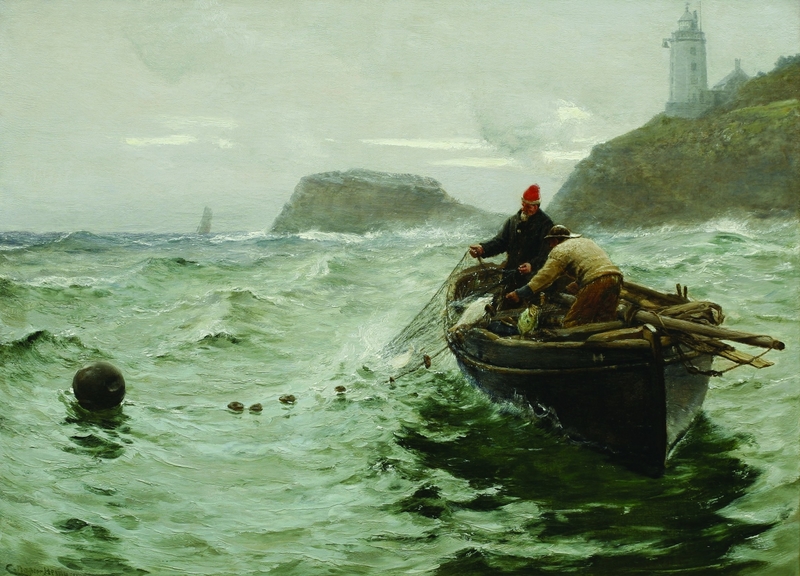
‘Along Shore Fisherman’ 1890 (Hauling a trammel net near St Anthony Lighthouse), Charles Napier Hemy, Falmouth Art Gallery.
The Bartlett Blog is written and produced by the volunteers who staff The Bartlett Maritime Research Centre and Library of National Maritime Museum Cornwall. This blog post was written by Linda Batchelor, a Bartlett Library volunteer.
The Bartlett Maritime Research Centre & Library holds a Collection of over 20,000 volumes and offers access to one of the finest collections of maritime reference books, periodicals and archival material. The Bartlett Blog reflects the diversity of material available in The Bartlett Library.

National Maritime
Museum Cornwall Trust
Discovery Quay
Falmouth Cornwall
TR11 3QY
View Map
See our opening hours
Tel: +44(0)1326 313388
Email: enquiries@nmmc.co.uk